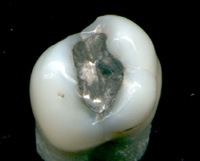Eco-friendly dentistry
An approach to dental practice that emphasizes environmental sustainability
Mercury is traditionally used in dental restorations known as amalgam|thumb]]
Eco-friendly dentistry, also known as green dentistry, is a practice of dentistry that aims to reduce the environmental impact of dental procedures and promote sustainability. This approach involves the implementation of environmentally friendly practices in dental offices, the use of sustainable materials, and the reduction of waste and energy consumption.
Principles of Eco-friendly Dentistry[edit | edit source]
Eco-friendly dentistry is based on several key principles that guide dental practices towards sustainability:
Reduction of Waste[edit | edit source]
One of the primary goals of eco-friendly dentistry is to minimize waste production. This can be achieved by:
- Using digital radiography instead of traditional X-rays, which reduces the need for chemical processing and film waste.
- Implementing digital record-keeping to eliminate paper waste.
- Encouraging the use of reusable or biodegradable products, such as cloth bibs and biodegradable cups.
Energy Efficiency[edit | edit source]
Dental practices can reduce their energy consumption by:
- Installing energy-efficient lighting, such as LED lights.
- Using energy-efficient dental equipment and appliances.
- Implementing smart thermostats and energy management systems to optimize energy use.
Water Conservation[edit | edit source]
Water conservation is another important aspect of eco-friendly dentistry. Practices can conserve water by:
- Installing low-flow faucets and toilets.
- Using waterless vacuum systems.
- Educating staff and patients about water-saving techniques.
Sustainable Materials[edit | edit source]
Eco-friendly dentistry promotes the use of sustainable materials, including:
- Biodegradable or recyclable dental products.
- Non-toxic and mercury-free dental amalgam alternatives.
- Environmentally friendly cleaning and sterilization products.
Pollution Prevention[edit | edit source]
Preventing pollution is crucial in eco-friendly dentistry. This can be achieved by:
- Proper disposal of hazardous waste, such as amalgam and lead foils.
- Using air filtration systems to reduce indoor air pollution.
- Choosing suppliers and products that adhere to environmental standards.
Benefits of Eco-friendly Dentistry[edit | edit source]
Eco-friendly dentistry offers numerous benefits, including:
- Reduced environmental impact and carbon footprint.
- Improved health and safety for patients and staff due to reduced exposure to toxic chemicals.
- Cost savings from reduced energy and water usage.
- Enhanced reputation and patient satisfaction by demonstrating a commitment to sustainability.
Challenges and Considerations[edit | edit source]
While eco-friendly dentistry offers many advantages, there are challenges to its implementation:
- Initial costs for upgrading equipment and facilities can be high.
- Training staff to adopt new practices and technologies requires time and resources.
- Balancing eco-friendly practices with patient care and regulatory requirements.
Related Pages[edit | edit source]
Search WikiMD
Ad.Tired of being Overweight? Try W8MD's NYC physician weight loss.
Semaglutide (Ozempic / Wegovy and Tirzepatide (Mounjaro / Zepbound) available. Call 718 946 5500.
Advertise on WikiMD
|
WikiMD's Wellness Encyclopedia |
| Let Food Be Thy Medicine Medicine Thy Food - Hippocrates |
Translate this page: - East Asian
中文,
日本,
한국어,
South Asian
हिन्दी,
தமிழ்,
తెలుగు,
Urdu,
ಕನ್ನಡ,
Southeast Asian
Indonesian,
Vietnamese,
Thai,
မြန်မာဘာသာ,
বাংলা
European
español,
Deutsch,
français,
Greek,
português do Brasil,
polski,
română,
русский,
Nederlands,
norsk,
svenska,
suomi,
Italian
Middle Eastern & African
عربى,
Turkish,
Persian,
Hebrew,
Afrikaans,
isiZulu,
Kiswahili,
Other
Bulgarian,
Hungarian,
Czech,
Swedish,
മലയാളം,
मराठी,
ਪੰਜਾਬੀ,
ગુજરાતી,
Portuguese,
Ukrainian
Medical Disclaimer: WikiMD is not a substitute for professional medical advice. The information on WikiMD is provided as an information resource only, may be incorrect, outdated or misleading, and is not to be used or relied on for any diagnostic or treatment purposes. Please consult your health care provider before making any healthcare decisions or for guidance about a specific medical condition. WikiMD expressly disclaims responsibility, and shall have no liability, for any damages, loss, injury, or liability whatsoever suffered as a result of your reliance on the information contained in this site. By visiting this site you agree to the foregoing terms and conditions, which may from time to time be changed or supplemented by WikiMD. If you do not agree to the foregoing terms and conditions, you should not enter or use this site. See full disclaimer.
Credits:Most images are courtesy of Wikimedia commons, and templates, categories Wikipedia, licensed under CC BY SA or similar.
Contributors: Prab R. Tumpati, MD

